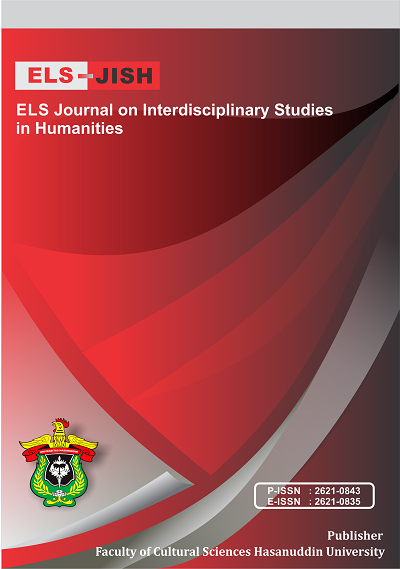An Analysis of Cognitive Level in Reading Questions of English Textbook for Vocational High School
DOI:
https://doi.org/10.34050/elsjish.v6i1.25225Keywords:
Cognitive Level, English Textbook, Revised Bloom's TaxonomyAbstract
The paper intends to analyze the cognitive level of questions from the text in the English Textbook. The researchers examined the cognitive level of the reading questions and the most dominant level in this book based on the levels of the revised edition of Bloom's Taxonomy. Because the information gathered was verbal, this study can be classified as a qualitative descriptive. The researchers used the textbook "Look Ahead Book 1 An English Course" as a data source and uses a checklist table in collecting and analyzing data to find research results. The researcher analyzes the questions in an English textbook, but only focuses on questions from the text in the chapter with narrative text. After doing the research, there are 2 chapters containing narrative text questions and there are 61 questions that are studied.The results showed that the level of questions in the book "Look Ahead Book 1 An English Course" only contains 5 levels, namely Remembering, Understanding, Applying, Analyzing, and Evaluating, which from the research results found the percentage of each level is 11, 48% for the Remembering level, 16.39% for the Understanding level, 1.64% for the Applying level, 47.54% for the Analyzing level and 22.95% for the Evaluating level. Hence, In terms of Bloom's taxonomy, the Analyzing level is the most prevalent here, making up 47.54 percent of the text.
References
Abdelrahman, M. S. B. (2014). An Analysis of the Tenth Grade English Language Textbooks Questions in Jordan Based on the Revised Edition of Bloom’s Taxonomy. Journal of Education and Practice, 5(18).
Anderson, L. W., Krathwohl, D. R., Airasian, P. W., Cruikshank, K. A., Mayer, R. E., Pintrich, P. R., Raths, J., & Wittrock, M. C. (2001). A Taxonomi for Learning, Teaching, and Assessing. Longman.
Armstrong, P. (2009). Overview of Bloom’s Taxonomy. Center for Teaching, 1.
Armstrong, Patricia. (2017). Bloom’s Taxonomy, center for teaching, Vanderbilt University. In Vanderbilt University.
Elo, S., Kääriäinen, M., Kanste, O., Pölkki, T., Utriainen, K., & Kyngäs, H. (2014). Qualitative Content Analysis: A Focus on Trustworthiness. SAGE Open, 4(1). https://doi.org/10.1177/2158244014522633
Febrina, Usman, B., & Muslem, A. (2019). Analysis of Reading Comprehensiom Questiom Using Revisd Bloom’s Taxonomy on Higher Order. English Education Journal, 10(1).
Gultom, P. O., & Gultom, J. J. (2021). Reading Comprehension Questions In English Textbook Based on Bloom’s Taxonomy for Grade XII. Register: Journal of English Language Teaching of FBS-Unimed, 10(3). https://doi.org/10.24114/reg.v10i3.29973
Hardi, V. A., & Rizal, M. S. (2020). Analisis Buku Teks Pelajaran Bahasa Inggris SD Berdasarkan Karateristik Pembelajar Muda pada Kelas Rendah. Jurnal Basicedu, 4(4), 1398–1407. https://doi.org/10.31004/basicedu.v4i4.605
Hsieh, H., & Shannon, S. E. (2005). Qualitative Health Research. Three Approaches to Qualitative Content Analysis. Qualitative Health Research, 15(15).
Rafiqa, R. (2017). The English Vocabulary Acquisition of the Students of State Junior High School 2 Parepare. EDUVELOP, 1(1). https://doi.org/10.31605/eduvelop.v1i1.8
Rafiqa, Yasim, S., Fajriani, Saleh, N. J., & Herawati. (2019). Development of translation learning package on task-based language teaching to improve learner‘s autonomy of English education students. International Journal of Scientific and Technology Research, 8(11), 2494–2497.
Raqqad, Y. M. Al, & Ismai, H. H. (2018). Analyzing The Reading Questions Of Ap12 Textbook According To Bloom’s Taxonomy. International Journal of Education, Psychology and Counseling, 3(22).
Sanli, C. (2019). Investigation of question types in high school geography coursebooks and their analysis in accordance with the Revised Bloom’s Taxonomy. Ege Cografya Dergisi, 28(2), 111–127.
Tayyeh, M. N. (2021). An Analysis Of Reading Comprehension Questions In English Textbook" English For Iraq" According To Revised Bloom’s Taxonomy. Turkish Journal of Computer and Mathematics Education (TURCOMAT), 12(7), 2868–2874.
Theresia, C., Gultom, J. J., & Siregar, T. M. (2021). Bloom’s Taxonomy on Reading Exercises in English Textbook “ Bahasa Inggris” for Grade Ten Senior High School Students. Register: Journal of English Language Teaching of FBS-Unimed, 8(4). https://doi.org/10.24114/reg.v8i4.24677
Wilson, L. O. (2016). Anderson and Krathwohl Bloom’s Taxonomy Revised Understanding the New Version of Bloom’s Taxonomy. The Second Principle.
Downloads
Published
Issue
Section
License
Copyright (c) 2023 Andi Mega Januarti Putri, Rafiqa Rafiqa, Ainun Apriawan

This work is licensed under a Creative Commons Attribution-ShareAlike 4.0 International License.






